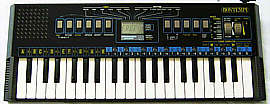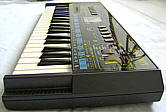 |
 |
|
Although this old Bontempi midsize keyboard with its LCD and grey plastic buttons looks like any plain ordinary digital tablehooter, it has a wonderful warm analogue sound with an astonishingly high quality speaker that is in no way comparable with those thin sounds and creaky yelling loudsqueakers found in later small Bontempis.
 |
 |
The main voice sounds is likely made from a basic waveform (squarewave?) that is heavily post- processed by clever analogue filters. (The resulting timbres don't sound much like squarewave.) The "piano" and "harpsi" employ a decay envelope. The other sounds have no envelope beside a slightly smoothened attack phase and sound rather organ- like. The "organ" sounds like a transistor organ and has quite strong vibrato. The "horn", "oboe" and "violin" employ the same but delayed vibrato. The "horn" has a dull timbre (same like "piano") while the "oboe" has a thin (quite realistic?) timbre and the "violin" a harsh one (same like "harpsi"?). When sustain is disabled, all sounds stop almost immediately after releasing the key. As a sound effect trick you can also step with the sound select button in realtime through all 6 preset sounds without stopping held notes, but by the lack of OBS buttons this is way less flexible than e.g. the button field on a Letron MC-3.
The vibrato is part of the sounds and can not be turned off. Like with the Hing Hon EK-001, the vibrato circuit seems to simply modulate the CPU clock oscillator, because it also affects chords and accompaniment and behaves monophonic, i.e. after a delayed vibrato has already faded in by a currently held note, the vibrato of any additional new notes starts immediately. When main voice sounds with delayed vibrato are selected, also the chord section gets the same vibrato (the vibrato fades in as soon the first key is pressed either in the main or chord section of the keyboard). Strange is that when chord notes are held by "chord memory" (with all keys released), it doesn't prevent the delay of a delayed main voice vibrato despite the held chord notes are still played with their vibrato; instead it simply stops the vibrato and then fades it in when the first key is pressed again.
This instrument seems to be a successor of the Bontempi Minstrel Beta hardware with many technical improvements; e.g. it features a polyphonic (i.e. normal behaving) piano decay envelope and the analogue percussion doesn't distort anymore and has high quality timbres with even a digital metallic cymbal waveform. The percussion seems to use digital tonal waveforms in combination with analogue capacitor envelopes (and filters?), because there is a single trimmer pot that tunes the pitch of all percussion sounds together. In spite of this they still sound very analogue and not like distorted lo-fi samples or the like. Unfortunately the controls of this instrument are a little cryptic and in no way OBS, but like the Minstrel Beta it has still a nicely versatile accompaniment; e.g. the arpeggio changes depending on how many chord keys are pressed and whether it is in fingered or single finger chord mode, and it can e.g. play a sequence of the same note from different octaves etc. The accompaniment accepts any key combinations and not only the few one establishment has defined to be "chords". When "chord memory" is off, the accompaniment falls silent by releasing the chord keys, which makes it possible to play with rhythms in interesting ways. You can even release individual chord keys here while holding the others; most other keyboards simply ignore this. The rhythm tempo can not be set really low and also only fairly high. The automatic accompaniment consists of short piano notes with e-bass and optional organ arpeggio. Without rhythm the chord section uses a plain organ tone; quite unusual is that unlike many modern keyboards in fingered chord mode its notes don't repeat here within one octave but behave like a real keyboard split.
When main voice sounds with vibrato are selected, the entire accompaniment (including bass and arpeggio) starts to howl out of sync with the rhythm in a charming way. This strangely enchanted effect reminds to certain great C64 homecomputer compositions (e.g. by Rob Hubbard) although the timbres of this instrument are much warmer and of higher quality and resemble rather a genuine Moog synthesizer or at least a good fullsize analogue home organ than the C64 SID soundchip. Regarding this wonderful instrument, it is such a shame what ear tormenting loud yelling, digital distorting lo-fi crap with tinniest speakers and no working volume control Bontempi did release in later years. Bontempi could have easily competed with Casio and Yamaha if they only had kept such high quality hardware and only had equipped it with state of the art software for more different rhythms and many complex sound envelopes instead of releasing things with only 6 preset sounds again and again and again until nobody wanted them anymore.
The case of the MRS 52/D is a quite costly and heavy construction with
a back printed transparent acryl control panel pane. The keyboard is mounted
with metal rails and sawed duroplastic parts. The small but high quality
4 Ohm loudspeaker (brand "Peitone") is designed for 5W power despite the
instrument's volume control can be only set to rather low volume (sounds
like about 0.25W?), thus this instrument plays much quieter than certain
terrible loud yelling later Bontempi keyboards, but in opposite
to these it makes a nice bass and almost no distortions.
Here is a tree view of the menu structure with explanation:
A simplified white toy variant of this instrument was released as
Bontempi
HT 313.10 (only 25 keys, no arpeggio, thinner sound, accompaniment
only playable through chord sequencer).
| removal of these screws voids warranty... | ||
 |
||
|
|